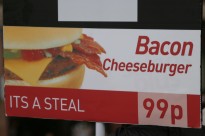
Sign in a New York City Duane Reade Store (photo by Sonny Datoy)
Every now and then I am reminded that standardized spelling is a relatively recent phenomenon. We tend to take it for granted now, but the world was not always so. In fact, William Shakespeare himself is rumored to have spelled his last name numerous ways, as did others during his lifetime. “Shakespeare” was the most common spelling then as it is now, but “Shakespere,” “Shakespear” and “Shake-speare” weren’t uncommon at all.
The printing press, the rise of vernacular languages, mass education and widespread literacy have led us to our present position — where dictionaries typically tell us there is one way, and only one way, to spell a given word. Of course, exceptions abound: “catalogue” and “catalog,” for example, are both considered correct.
But for the most part, there is only one way. And a good many people get angry when they encounter misspellings. I am one such person. Years ago, however, I decided to have some fun with my anger — and so I began taking photos of incorrect English, both at home and abroad.

Seeking a Fairy/Ferry from Denmark to Germany (photo by Justin Snider)
Some of the “bad English,” as I like to call it, redeems itself by being funny. The person soliciting donations for a “fairy” ride from Denmark to Germany made me smile and laugh — and almost contribute a Euro or two. I wondered then, as I do now, whether it’s cheaper to get from Denmark to Germany by fairy or ferry.
Then there’s the sloppiness we see by people who think punctuation is always optional, like wearing sunglasses or flossing one’s teeth. No, I tell my students, commas, periods, hyphens, dashes, colons, semi-colons and apostrophes all serve distinct purposes and often aren’t optional. They facilitate reading, just as standardized spelling does. If you don’t believe me, maybe Lynn Truss’ Eats, Shoots & Leaves will convince you.

A McDonalds Sign in London (photo by Justin Snider)
I especially dislike missing or misused apostrophes. (Come on, people, they’re not that hard to master!) Why is it that “its” and “it’s” are so difficult for some folks?
But whenever my anger flares up, I recall this bizarre fact: Our brains are very good at unscrambling misspelled words and making sense of them. Try for yourself with this famous example:
“I cdnuolt blveiee taht I cluod aulaclty uesdnatnrd waht I was rdanieg. The phaonmneal pweor of the hmuan mnid! Aoccdrnig to rseaerch at Cmabrigde Uinervtisy, it desont mttaer in waht oredr the ltteers in a wrod are, the olny iprmoatnt tihng is taht the frist and lsat ltteer be in the rghit pclae.
The rset can be a taotl mses and you can sitll raed it wouthit a porbelm. Tihs is bcuseae the huamn mnid deos not raed ervey lteter by istlef, but the wrod as a wlohe. Amzanig eh? And I awlyas tohghut slpeling was ipmorantt!”
My ability to read and understand this passage makes me think that maybe, just maybe, correct spelling is overrated. Maybe I’m too uptight about spelling specifically and grammar in general. Maybe spelling no longer matters in the Age of the Internet and Text-Message. Or not? An argument against a “spell-however-you-see-fit” society is that even if you can still decode what’s been written, doing so takes longer than it could or should. The passage above provides proof: yes, you can decipher what it says, but it’s rather slow-going. And taxing.
In closing, I must mention an absolutely brilliant and hilarious piece in yesterday’s New York Times that looked at “Chinglish,” or Chinese English. The story is not so much about bad spellings as bad translations, but the idea is the same. And the slideshow will have you rolling on the floor laughing, which my students tell me is spelled ROTFL.



